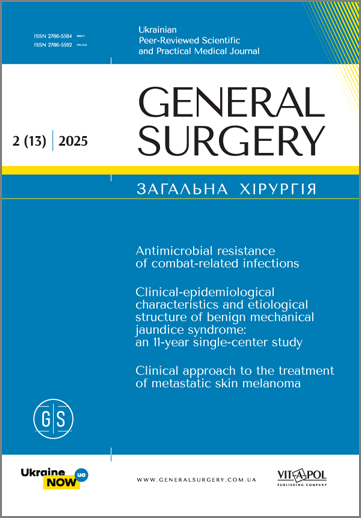A clinical case of surgical treatment of complicated chronic venous insufficiency using the principles of hemodynamic management
DOI:
https://doi.org/10.30978/GS-2025-2-62Keywords:
varicose disease, chronic venous insufficiency, hemodynamic management, post‑thrombotic syndromeAbstract
Chronic venous disease is a widespread condition that involves telangiectasias, reticular veins, varicose veins, and venous ulcers. In addition to the well‑known manifestations and complications, long‑term persistent chronic venous insufficiency (CVI) can become a factor that contributes to the development of infectious processes in the skin and subcutaneous fat. If the inflammatory lesion spreads deeper, phlegmon and deep vein thrombosis may occur. 20% to 50% of patients suffering from deep vein thrombosis develop post‑thrombotic syndrome.
A 59‑year‑old patient turned to the department of surgery with complaints of severe swelling of the right lower limb, darkening and thickening of the skin, the presence of several wounds from which pus periodically oozed, varicose veins, intermittent pain, and a feeling of distension in the affected limb. A year ago, she was hospitalized with recurrent erysipelas of the right lower limb, which was complicated by phlegmon and required surgery. Over the past year, she had noticed severe swelling of the limb, and the right lower leg had darkened considerably. During ultrasound Doppler mapping, we detected signs of past deep vein thrombosis with partial recanalization at the level of the popliteal vein, incompetence of the saphenofemoral junction, dilation of the great saphenous vein and its tributaries, and incompetence of the perforating veins in the lower third of the leg. The surgical intervention followed the principles of hemodynamic management. After ten and a half months, the patient was fully satisfied with the treatment outcomes. The limb showed no swelling, hyperpigmentation significantly decreased, and the chronic wounds completely healed.
For patients with complicated CVI, a history of inflammatory skin and subcutaneous fat diseases, and an incompetent deep venous system, hemodynamic conservative treatment or CHIVA (Cure Conservatrice et Hemodynamique de l’Insufficience Veineuse en Ambulatoire) is the preferred option. This technique requires a detailed ultrasound Doppler mapping of the venous network and is personalized for each patient. This treatment approach can yield the most stable long‑term results, the disappearance of all or most symptoms of CVI, and favourable cosmetic outcomes.
References
Azar J, Rao A, Oropallo A. Chronic venous insufficiency: a comprehensive review of management. J Wound Care. 2022;31(6):510-9. http://doi.org/10.12968/jowc.2022.31.6.510.
Bellmunt-Montoya S, Escribano JM, Pantoja Bustillos PE, Tello-Díaz C, Martinez-Zapata MJ. CHIVA method for the treatment of chronic venous insufficiency. Cochrane Database Syst Rev. 2021 Sep 30;9(9):CD009648. http://doi.org/10.1002/14651858.CD009648.pub4. PMID: 34590305; PMCID: PMC8481765.
Borgel D, Bianchini E, Lasne D, Pascreau T, Saller F. Inflammation in deep vein thrombosis: a therapeutic target? Hematology. 2019 Dec;24(1):742-750. http://doi.org/10.1080/16078454.2019.1687144. PMID: 31736432.
Chaitidis N, Kokkinidis DG, Papadopoulou Z, Hasemaki N, Attaran R, Bakoyiannis C. Management of Post-thrombotic Syndrome: A Comprehensive Review. Curr Pharm Des. 2022;28(7):550-559. http://doi.org/10.2174/1381612828666220131094655. PMID: 35100955.
Faccini FP, Arendt AL, Pereira RQ, de Oliveira AR. CHIVA to spare the small and great saphenous veins after wrong-site surgery on a normal saphenous vein: a case report. J Vasc Bras. 2019 Jan 7;18:e20180077. http://doi.org/10.1590/1677-5449.007718. PMID: 31191627; PMCID: PMC6542319.
Gowda SK, Garg S, Behera B, Thakur V, Sahu DK. Mimickers of erysipelas and cellulitis: A narrative review. Indian J Dermatol Venereol Leprol. 2025;91(3):346-55. http://doi.org/10.25259/IJDVL_160_2024.
Kolosovych IV, Korolova KO, Teplyi VV, Korolova ZV, Sydorenko RA. The importance of the prognostic score for the choice of CHIVA hemodynamic surgery as a treatment method for varicose veins of the lower extremities. Wiad Lek. 2023;76(7):1562-8. doi: 10.36740/WLek202307108.
Mangwani J, Roberts V, Shannak O, Divall P, Srinivasan A, Dias J. Epidemiology and Diagnosis of Post-Thrombotic Syndrome: Qualitative Synthesis with a Systematic Review. J Clin Med. 2023 Sep 11;12(18):5896. http://doi.org/10.3390/jcm12185896. PMID: 37762837; PMCID: PMC10532000.
Rinfret F, Gu CS, Vedantham S, Kahn SR. New and known predictors of the postthrombotic syndrome: A subanalysis of the ATTRACT trial. Res Pract Thromb Haemost. 2022;6(6):e12796. Published 2022 Aug 29. http://doi.org/10.1002/rth2.12796.
Rodrigues MA, Caetano M, Amorim I, Selores M. Dermo-Hipodermites Bacterianas Agudas Não Necrotizantes: Erisipela e Celulite Infeciosa [Non-Necrotizing Acute Dermo-Hypodermal Infections: Erysipela and Infectious Cellulitis]. Acta Med Port. 2021 Mar 1;34(3):217-228. Portuguese. http://doi.org/10.20344/amp.12642. Epub 2021 Mar 1. PMID: 33971117.
Visonà A, Quere I, Mazzolai L, Amitrano M, Lugli M, Madaric J, Prandoni P; European Society of Vascular Medicine (ESVM). Post-thrombotic syndrome. Vasa. 2021 Sep;50(5):331-340. http://doi.org/10.1024/0301-1526/a000946. Epub 2021 Mar 15. PMID: 33720757.
Downloads
Published
How to Cite
Issue
Section
License
Copyright (c) 2025 Authors

This work is licensed under a Creative Commons Attribution-NoDerivatives 4.0 International License.






